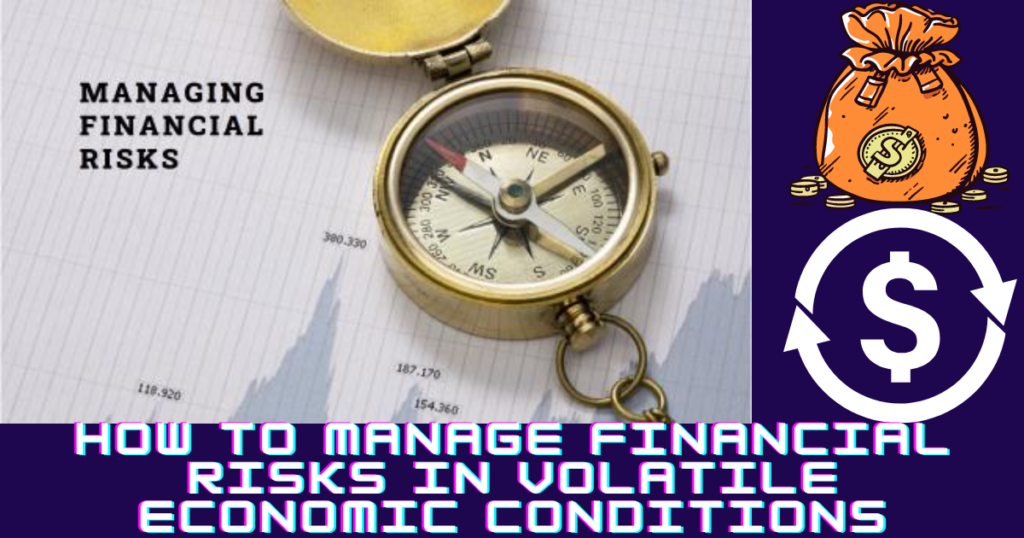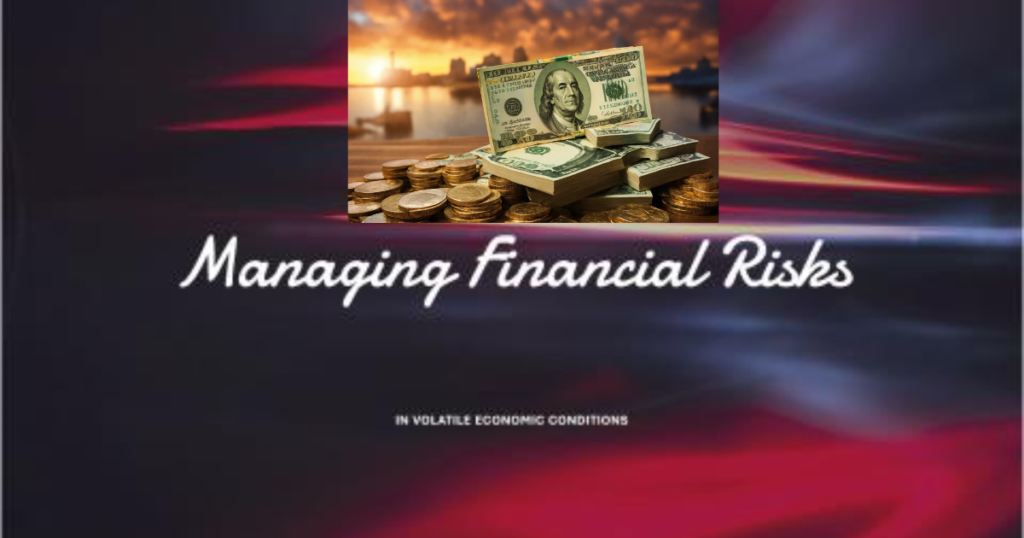Introduction
In the dynamic landscape of today’s business world, enterprises grapple with an array of financial risks linked to leveraging. The intricacies become more pronounced in the face of economic volatility, posing a formidable challenge to companies in steering their investments towards long-term objectives. This response delves into 13 distinctive strategies that companies can embrace to effectively how to deal financial risks tied to leveraging during periods of economic uncertainty.

13 distinctive strategies how to deal financial risks tied to leveraging during periods of economic uncertainty.
- 1. Cultivate a Well-Balanced and Diversified Investment Portfolio:
- 2. Explore Outsourced Investment Management for Volatility:
- 3. Uphold Robust Cash Flow Management:
- 4. Embrace a Margin of Safety: To deal Financial Risks
- 5. Adopt a Long-Term Perspective:
- 6. Foster Continuous Learning: To deal Financial Risks
- 7. Leverage Technology for Real-Time Risk Monitoring:
- 8. Safeguard Intellectual Property: To deal Financial Risks
- 9. Assess Active Management Approaches:
- 10. Review Resources and Governance Structure:
- 11. Balance Nimble Investment Approaches with Appropriate Risk Controls:
- 12. Rebalance with Discipline: To deal Financial Risks
- 13. Explore Market Opportunities:
- Conclusion:
- Here are responses to the FAQs: How to deal Financial Risks
- Disclaimer
1. Cultivate a Well-Balanced and Diversified Investment Portfolio:
A judiciously diversified investment portfolio acts as a safeguard, offering companies the means to manage risks, optimize returns, and ensure liquidity amid turbulent market conditions. This involves a strategic allocation across various asset classes such as stocks, bonds, and cash, spanning diverse sectors and geographies.
2. Explore Outsourced Investment Management for Volatility:
Delegating investment management to external experts proves instrumental in navigating market volatility. This outsourcing strategy empowers companies to tap into specialized expertise and resources, relieving them of the in-house burden associated with managing investments.
3. Uphold Robust Cash Flow Management:
Maintaining a healthy cash flow or securing access to a reliable line of credit is pivotal for companies to sidestep threats and capitalize on emerging opportunities. A prudent approach involves maintaining a cash reserve equivalent to three to six months of expenses and establishing a line of credit with a reputable financial institution.
4. Embrace a Margin of Safety: To deal Financial Risks
Safeguarding investments against downside risks entails maintaining a buffer or margin of safety. This not only enhances tax treatment but also fosters an overall enhanced investing experience. Companies should carefully consider and implement a margin of safety within their investment strategies.
5. Adopt a Long-Term Perspective:
Amid market volatility, adopting a steadfast long-term perspective aids companies in making informed decisions, steering clear of emotionally driven or reactive choices. Focusing on overarching long-term goals becomes imperative, preventing the sway of short-term market fluctuations.
6. Foster Continuous Learning: To deal Financial Risks
Encouraging a culture of continuous learning equips companies to stay abreast of evolving market trends. Employees should be incentivized to partake in training programs, attend conferences, and delve into industry publications to stay well-informed about market dynamics.
7. Leverage Technology for Real-Time Risk Monitoring:
Harnessing technology for real-time risk monitoring enables companies to swiftly identify potential threats and opportunities. Incorporating risk management software and other technological tools facilitates prompt responses to fluctuating market conditions.

8. Safeguard Intellectual Property: To deal Financial Risks
In volatile economic climates, intellectual property emerges as a potent hedge. Companies should invest in research and development to fortify their intellectual property, creating a shield against economic downturns while fostering innovation in products and services.
9. Assess Active Management Approaches:
Evaluating active management approaches versus passive or factor-based investments aids companies in determining the most suitable investment strategy. An informed decision, weighing the pros and cons, aligns the chosen approach with long-term goals and risk tolerance.
10. Review Resources and Governance Structure:
Scrutinizing the roles of advisors, staff, and investment committees clarifies the decision-making process. Companies should reassess their resources and governance structure, ensuring the presence of adept individuals to facilitate well-informed investment decisions.
11. Balance Nimble Investment Approaches with Appropriate Risk Controls:
Striking a balance between agility in investment approaches and maintaining effective risk controls is crucial. A flexible investment strategy responsive to market changes must coexist with robust risk controls to mitigate potential downsides.
12. Rebalance with Discipline: To deal Financial Risks
Regularly reviewing the investment policy statement (IPS) guides long-term asset allocation and rebalancing. Periodic assessments and adjustments ensure that portfolios remain aligned with predetermined long-term goals and risk tolerance levels.
13. Explore Market Opportunities:
Embedding flexibility into the investment policy by earmarking allocations for opportunistic ventures empowers companies to swiftly adapt to changing conditions. Allocating a portion of the portfolio to seize market opportunities during volatility enhances overall resilience.
Conclusion:
In conclusion, the management of financial risks associated with leveraging in unpredictable economic conditions necessitates the adoption of a multifaceted approach. By implementing strategies such as cultivating a diversified investment portfolio, ensuring robust cash flow, leveraging technology for real-time risk monitoring, and safeguarding intellectual property, companies can navigate risks, capitalize on opportunities, and realize their long-term goals.
Here are responses to the FAQs: How to deal Financial Risks
Q1. How do you manage/ deal Financial risks in the financial industry during market volatility?
Managing risks in the financial industry during market volatility involves a combination of strategic planning and agile decision-making. Here are key approaches:
- Diversification: Maintain a well-diversified portfolio across different asset classes to spread risks and minimize the impact of volatility in any single sector.
- Continuous Monitoring: Use advanced risk management tools and technologies to monitor market conditions in real-time. This enables swift identification of potential threats and opportunities.
- Hedging Strategies: Employ hedging techniques, such as options and futures, to protect against adverse market movements and limit potential losses.
- Stress Testing: Regularly conduct stress tests to assess how your portfolio would perform under extreme market conditions. This helps in identifying vulnerabilities and making proactive adjustments.
- Liquidity Management: Ensure sufficient liquidity or access to credit to meet financial obligations during periods of heightened volatility.
Q2. What is the best way to deal with volatility?
Dealing with volatility requires a comprehensive and proactive approach. Consider the following strategies:
- Long-Term Perspective: Focus on long-term financial goals and avoid making impulsive decisions based on short-term market fluctuations. This helps in riding out temporary volatility.
- Diversification: Build a diversified investment portfolio across various asset classes, industries, and geographic regions. Diversification helps to spread risk and minimize the impact of volatility on the overall portfolio.
- Risk Tolerance Assessment: Understand your risk tolerance and invest accordingly. Align your investment strategy with your risk tolerance to ensure you can weather market fluctuations without making emotionally-driven decisions.
- Stay Informed: Keep abreast of economic indicators, market trends, and geopolitical events. Informed decision-making is crucial in navigating volatile markets.
- Regular Portfolio Review: Periodically review your investment portfolio to ensure it remains aligned with your financial goals. Rebalance when necessary to maintain the desired asset allocation.
Q3. How can volatility risk be reduced?
Reducing volatility risk involves a combination of risk management strategies and prudent financial planning. Here are some effective measures:
- Asset Allocation: Allocate assets based on your risk tolerance and investment goals. Adjust the mix of stocks, bonds, and cash to create a well-balanced portfolio that aligns with your risk appetite.
- Quality Investments: Focus on high-quality, fundamentally sound investments. Quality assets with strong fundamentals may exhibit more resilience during periods of volatility.
- Diversification: Spread investments across different sectors, industries, and geographic regions. Diversification helps to minimize the impact of adverse events in any single area.
- Derivative Instruments: Consider using derivative instruments, such as options and futures, to hedge against specific risks. These financial instruments can provide a level of protection during volatile market conditions.
- Stay Liquid: Maintain sufficient liquidity in your portfolio to seize opportunities or address unexpected financial needs during periods of market turbulence.
Q5. How can I manage my financial risks?
Managing financial risks requires a holistic approach encompassing various aspects of personal or business finances. Here are key steps:
- Budgeting and Cash Flow Management: Create a comprehensive budget that accounts for income, expenses, and savings goals. Effective cash flow management ensures you can meet financial obligations and build a financial cushion.
- Emergency Fund: Establish an emergency fund to cover at least three to six months’ worth of living expenses. This provides a financial safety net during unexpected events or income disruptions.
- Insurance Coverage: Adequate insurance coverage, including health, life, and property insurance, helps mitigate risks associated with unforeseen events.
- Investment Diversification: Diversify your investments across different asset classes to spread risk. This includes stocks, bonds, real estate, and other investment vehicles.
- Debt Management: Manage debt responsibly, focusing on reducing high-interest debts and avoiding over-leveraging. This ensures financial stability and reduces the impact of interest rate fluctuations.
- Regular Financial Check-Ups: Periodically review and adjust your financial plan based on changing circumstances, goals, and market conditions.
By integrating these strategies into your financial planning, you can proactively manage and mitigate various risks, promoting financial stability and resilience.
Disclaimer
This article has been created on the basis of internal data, information available publicly, and other reliable sources to be believed. The article may also include information which are the personal views/opinions of the authors. The information included in this article is for general, educational, and awareness purposes only and is not a full disclosure of every material fact.
All the information on this website i.e. World Virtual CFO – is published in good faith and for general information purposes only. World Virtual CFO does not make any warranties about the completeness, reliability, and accuracy of this information. These are my views for only information purposes. Any action you take upon the information you find on this website (World Virtual CFO), is strictly at your own risk. World Virtual CFO will not be liable for any losses and/or damages in connection with using our website. For details please refer to our disclaimer page.
Dr. Dinesh Sharma is an award-winning CFO and AI strategist with over two decades of experience in financial leadership, digital transformation, and business optimization. As the founder of multiple niche platforms—including WorldVirtualCFO.com—he empowers professionals and organizations with strategic insights, system structuring, and innovative tools for sustainable growth. His blogs and e-books blend precision with vision, making complex financial and technological concepts accessible and actionable.
1 thought on “How to deal Financial Risks in Volatile Economic Conditions”